Google any of the innumerable lines of suave salesmanship intoned by Don Draper over Mad Men's ninety-two hours, and you'll find them recycled into career-lesson listicles on LinkedIn and ZipRecruiter, an unsurprising afterlife since those scenes of seal-the-deal philosophizing were as much self-help as sales pitch: "You are the product. You feel something. That's what sells"; or, "Success comes from standing out. Not fitting in."1 Such ad-man kōans circulate bereft of context in low-end managerial discourse promising to help readers shine amid competitive white-collar labor markets.2 We may begin untangling the ideological web connecting those managerial discourses, labor markets, and the rise of prestige dramas like Mad Men by tugging on the thread of another of Don's pitch-proverbs: "Change is neither good or bad; it simply is. It can be greeted with terror or joy. A tantrum that says, 'I want it the way it was,' or a dance that says 'Look, something new.'"3
Recontextualized in its episode, "Love Among the Ruins," this pitch aims to flatter Edgar Raffit, fictional lead of Madison Square Garden's development project, who plans to raze Penn Station, the 1963 destruction of which is bad change par excellence, like "the Romans [taking] apart the Colosseum to make their outhouses," as copywriter Paul Kinsey quips.4 The "change" line also comments obliquely on Don's own self-reinventions — his stolen identity and serial infidelities — none of which stave off memories of his youth as Dick Whitman, lowly brothel orphan. The line may even poke at the divided impulses behind Mad Men's much-hyped historicism, which romanticizes the past with curatorial care while scolding the bigotries and stupefactions that place it "back then" — beneath the self-conception of its mostly high-income, Obama-era viewership. In short, Don's sales patter about change yields layers of irony and conflicting reference — perhaps even a reflexive critique of commerce and of the program itself as historical representation — but this has little to do with the line's appeal to internet career counselors who court web traffic by repackaging low-calorie versions of Nietzsche's Zarathustra for readers harried by neoliberal imperatives to self-entrepreneurship.5
Better fitted to such purposes is the scene's most celebrated line, when Don tells Raffit, "if you don't like what's being said, change the conversation." The magic of this second affirmation of "change" depends on two grammatical shifts. The first is a movement in lexical categories from "change" (the noun which "simply is") to "change" (the imperative verb), while the second is a shift in semantic roles, moving from tantrum-throwing, Penn-Station-loving aesthetes — grammatical patients enduring change — to Raffit himself, listener made grammatical agent, the entrepreneur creating change, making the weather of creative destruction. This syntactic legerdemain revises the conventional art/commerce dichotomy with a result that, to quote another pitch, is "subtle but potent."6 Don's rhetoric implies that the true artists are not beatnik detractors like Paul Kinsey but visionary execs like Raffit. To avoid becoming a pure object in this world, one must become a subject — by getting creative and changing the subject. Business, not art — or rather, business-as-art — takes on the consecrated aura of originality and vision accorded since the nineteenth-century to aesthetic creation.
This fusion of art and commerce is hardly new. In Joseph Schumpeter's romanticized vision, the "artist who was both an engineer and an entrepreneur" typified capitalism's heroic initial period.7 Nonetheless, because of explosive growth in the power of creative industries in recent decades, this synthesis of art and commerce under the sign of extraordinary leadership — auteur entrepreneurship — has again become a mainstay within the capitalist imaginary. The most exultant account of that synthesis is surely Richard Florida's Rise of the Creative Class, which heralds a new class engaged in knowledge-work, problem-solving, and problem-finding. 8 Florida can't help but nod appreciatively at the virtues his creatives infuse into the business world: an appreciation for diversity, casual dress, flexible hours, and meritocratic principles.9 Against this Floridian complacency, where markets and creativity meet as happily as sand and surf, critics have highlighted creative capitalism's covert benefits to management at labor's expense. Scholars such as Angela McRobbie, Mark Banks, and Sarah Brouillette have attended to the ideological and psychological implications of a structural imbalance between the labor market demand for creatives and the even larger supply of aspirants drawn by romantic conceptions of creative labor as central to self-realization.10 Within creative-economic discourses — in Brouillette's description — creativity, understood as "synonymous with a welcome embrace of ceaseless change," becomes the "the privileged marker of one's personal evolution toward a reflexive capitalist modernity."11
The most compelling account of capitalism's ideological relationship to creativity remains Luc Boltanski and Eve Chiapello's The New Spirit of Capitalism (hereafter NSC), which distinguishes between social and artistic critiques of capitalism. The social critique — emphasized by the labor movement — opposes the social inequalities, worker exploitation, and egotistical disdain for the welfare of others that prevail under capitalism. The artistic critique — embodied by Baudelaire — counters capitalism's profit-motive with the artist's freedom and unwillingness to contaminate aesthetics with markets or ethics. NSC shows that, between the 1960s and 1990s, management theory began inscribing managerial discourse with erstwhile bohemian values, suggesting larger changes in the normative framework for capital accumulation.12 The "new spirit" of capitalism (which I follow NSC in calling connectionism) embraces bohemian ideals of personal authenticity (against hypocritical social orthodoxies and mass consumption's pervasive phoniness) and individual autonomy (against industrial labor's regimentations and welfare-state complacencies). The result has been "a fading of the opposition, on which the artistic critique had been based for a century, between intellectuals and businessmen [ . . . ] between artists and bourgeois."13
This essay seeks a new angle of critique on that faded opposition by examining how knowledge-work is portrayed in AMC's two costume dramas of creative destruction: Mad Men and Halt and Catch Fire. These programs are apt sites for reading tensions at play in capitalism's recuperation of the artistic critique because they track the development of key creative industries in postwar U.S. history and suggest how they've shaped the lifeworld of contemporary viewers.14 Both draw on connectionism's romance of the auteur entrepreneur, who is both native to and heroically generative of change, but neither should be dismissed as mere ideological façades.15 Both programs present connectionist romances while nonetheless emphasizing conflicts unresolved in creative-economic discourses: the erasure of personal and professional boundaries, the contradiction between authenticity and marketability, the risk of unacknowledged contributions, the tensions between invention and commercialization, and the human costs that come with pursuing what Brouillette calls "the market value of an authentic self."16
I begin by re-reading Mad Men's depiction of capitalism through NSC's "three spirits" periodization before focusing on the show's defining and conflicted interest in creative labor. An instability embedded in ideas about "the creative," whose work is both ordinary and extraordinary, characterizes the program's ambivalent investment in connectionism, an investment supplemented by what Nancy Fraser calls the romance of female advancement. I then consider Halt as an inheritor ofboth Mad Men's period workplace form and its fascination with connectionism. Where Mad Men is preoccupied with creativity's ambiguous status in workplace and marketplace, Halt explores the recent consecration of innovation via a set of four connectionist tropes. I conclude by offering notes toward the historicization of these costume dramas of creative destruction, which should be recognized as not only acts of popular memory retelling recent economic history but also cultural industrial enterprises which themselves instantiate the kinds of conflicted creative labor they dramatize, embodying auteur-entrepreneurial tensions at the level of production and reception.17 By unknotting the tangled fantasies and anxieties about knowledge-work these series dramatize, we may gauge how credible the promise of creative capitalism remains among their largely white-collar audiences.
Mad Men: The Most Important Least Important Thing
DON: Do you know why I don't want to go to McCann?
PEGGY: Because you can't work for anyone else.
DON: No. Because there are people out there who buy things, people like you and me, and something happened. Something terrible. And the way that they saw themselves is gone. And nobody understands that. But you do. And that's very valuable.
PEGGY: Is it?18
Why exactly doesn't Don Draper want to work for McCann Erickson? The vague exchange quoted above between Don and his protégé Peggy Olsen occurs amid a scramble to evade McCann's corporate takeover of Sterling Cooper in the third season's finale, but from Mad Men's first to its final season, the prospect of high-salaried employment at the most powerful firm in Don's industry is treated as a form of mortal injury. Don's antipathy to McCann is bound up with the program's ambivalent enchantment with creative labor, but grasping this requires a broader view of Mad Men's presentation of twentieth-century American capitalism. In what follows, I map that presentation onto NSC'sthree "spirits" of capitalism, each of which designates a set of normative frameworks incentivizing participation in the economic order.19
The first spirit of capitalism prevailed amid nineteenth-century competitive industrialization. Its social imaginary exalted the heroic entrepreneur — gutsy adventurer, daring conquistador, captain of industry — who took risks at work but at home embraced bourgeois domestic values like parsimony, saving, the tending of familial inheritance. NSC links this directly to Schumpeter's presentation of the entrepreneurial bourgeoisie's world vision of laissez-faire virtues and Social Darwinism. This spirit justified the social upheavals of industrialization in terms of a utilitarian pursuit of progress benefiting all, but it was vulnerable to charges of hypocrisy because its domestic sanctimonies obviously clashed with the rapacious acquisitiveness it displayed elsewhere. I take the cheerfully overpaid loafer Roger Sterling (fig. 1) to embody this first spirit's nepotistic legacy, which lingered well beyond the nineteenth century in the form of unproductive scions draining carefully tended inheritances. Justifying his huge salary at the white-shoe agency his father co-founded, Roger shrugs: "Nobody knows what I'm doing. It's good for mystique."20 When his agency reorganizes, they understandably leave Roger off the org chart, but he thinks he's just "being punished for making my job look easy."21
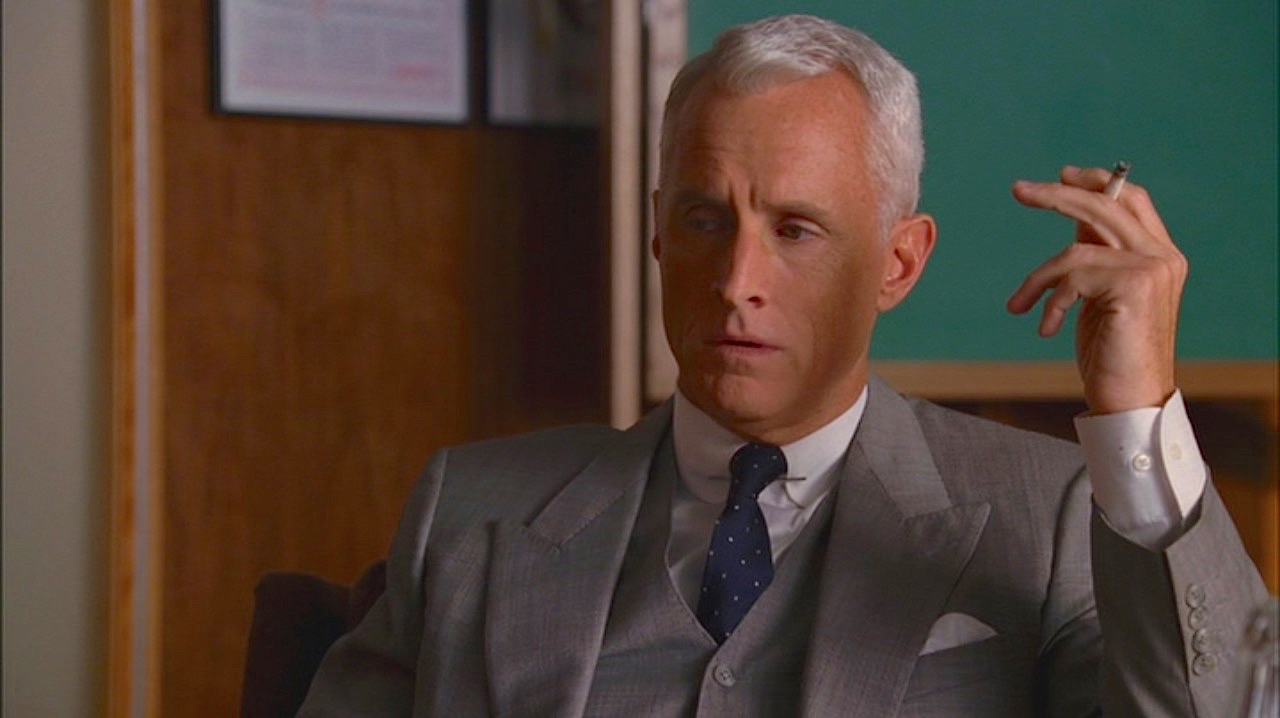
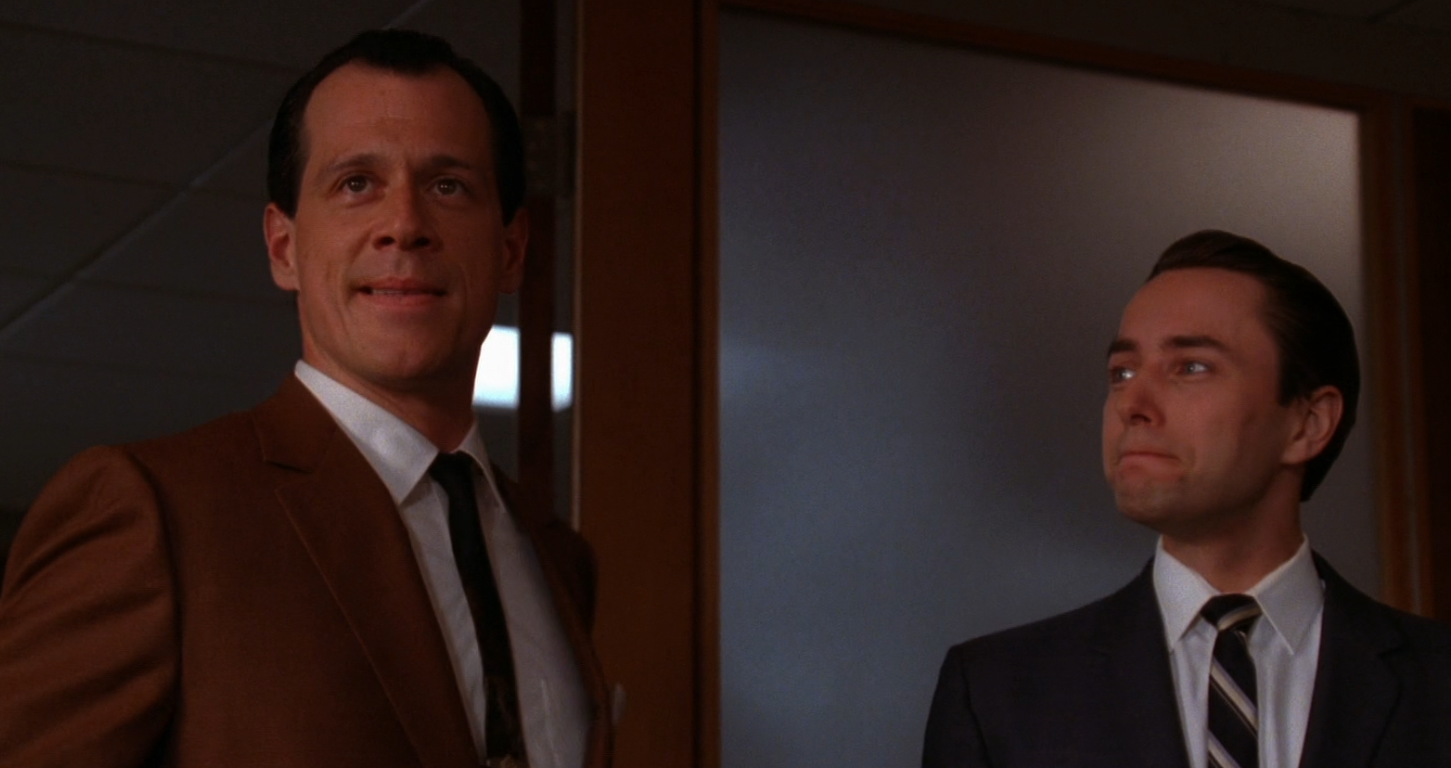
Though the program delights in Roger as a kind of Restoration rake, giving him its best lines and finest three-piece suits, it does not venerate the social force he embodies. Beneficiary of nepotism, Roger pays it forward by foisting Danny, talentless cousin of his second wife, onto his staff, but this is the least of his offenses. He is as defined by his vanity and faithlessness (not least in his relationship with office manager Joan Holloway) as by his wit. The robber barons' reign had been bountiful for people like Roger. "In another life," affirms Don, "I would have been your chauffeur."22 In Mad Men's timeframe, though, Roger's sheen of cosmopolitan privilege mingles with a sense of belatedness. What's left for him is draining highballs, corporate cosplay, and nursing the family fortune. Whatever its affections for Roger, the show's disparagement of aristocratic capital is evident in its other scions and captains of industry (fig. 2), who range from the vicious (imperious hotelier Conrad Hilton, Lucky Strike's malevolent Lee Garner, Jr.) to the inadequate (the desexed Bertram Cooper and the somehow winningly contemptable Pete Campbell, a descendent of the Dyckmans, who once "owned pretty much everything north of 125th Street").23 All the agency's account executives — Roger, Pete, Ken Cosgrove — are scions of industry by blood or marriage, whose primary work — mounting "golf-and-dining offensive[s]" — depends on leveraging social capital furnished through nepotistic legacies established under the first spirit's aegis.24
By 1960, when the series begins, such dynastic capitalism had long been superseded by publicly traded, professionally managed blue chips. These large firms heralded NSC's second spirit, which championed professionalism and managerial rationality. This period of monopolistic capital was dominated by large industrial firms headed not by owners, who withdrew to the role of shareholders, but by a new social body of administrators. Its heroic figure was the director, preoccupied by the task of growing his firm through "mass production, based on economies of scale, product standardization, [and] the rational organization of work."25 Where the first spirit often placed incompetent relatives in managerial positions to secure capital transmission along family lines, the second spirit favored impersonal judgment based on objective results. What Galbraith called the "technostructure" and Burnham decried as the "managerial revolution" emerges once ownership gets separated from the day-to-day management of capital: the former retreats into anonymity while the latter expands and rewards itself.26
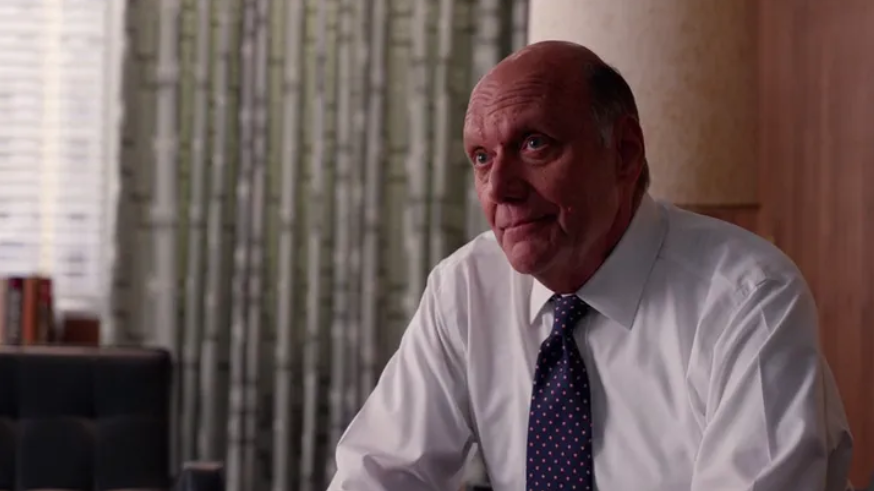
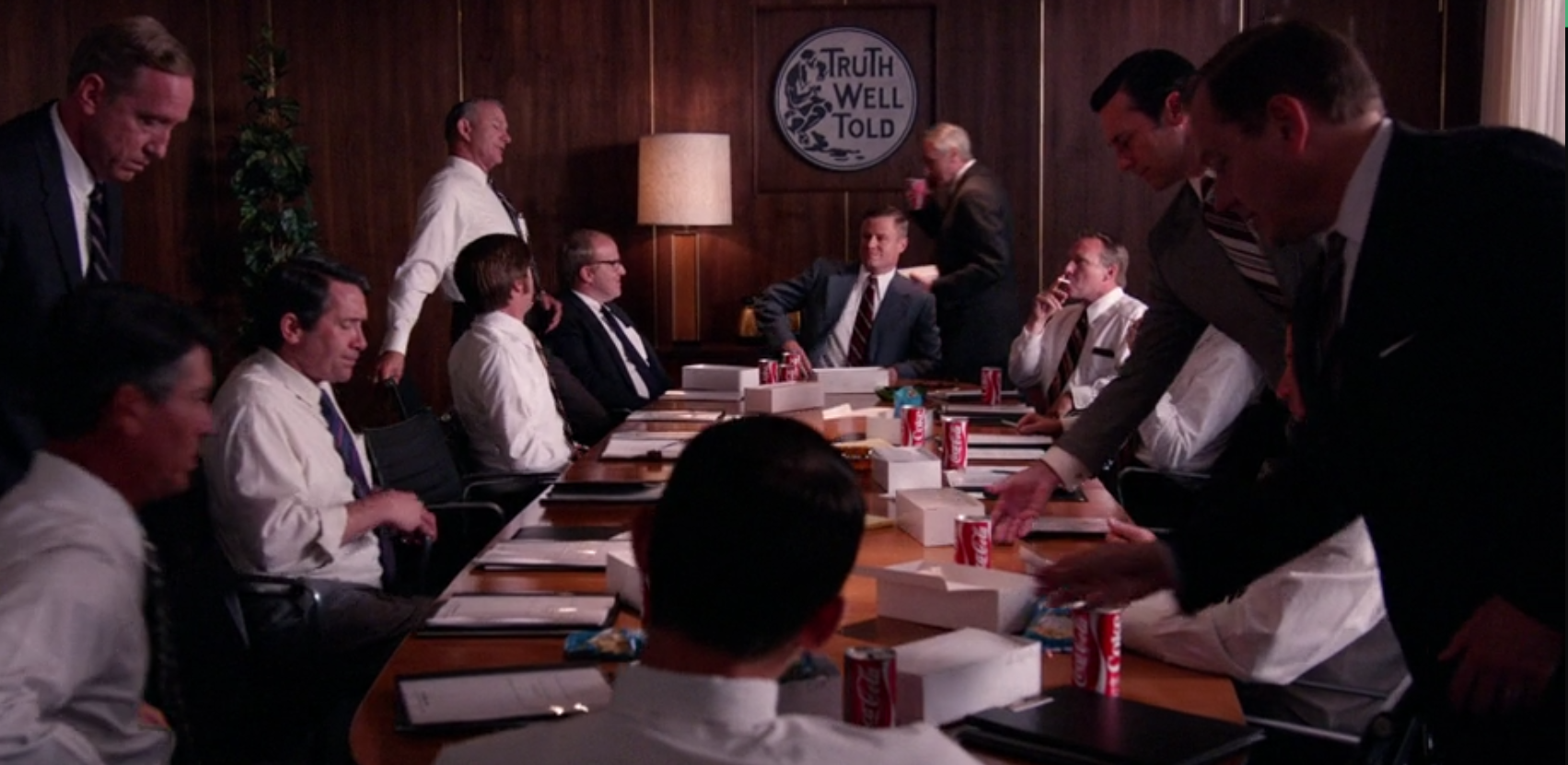
If Mad Men is ambivalent about the first spirit, it's venomously hostile to the second. Chevrolet is presented as both over-rationalized and barbaric, a place of red tape and red teeth. Creative pitches for Chevy must work through a three-year calendar of deadlines, explains Ken Cosgrove: "It's gotta kick its way up the ladder through all of GM until it gets to God, and then he's gotta run it past his wife."27 This bureaucratic bloat is just one of the monstrous firm's horns: administrative redundancies have spawned idle managers occupying their hours with demonic contests of manhood and bacchanalian riot. While working for Chevy in Detroit, Cosgrove's life is repeatedly threatened by intoxicated execs. He's forced to drive blind in a new Impala and loses an eye to an executive's shotgun. However nightmarish Chevy appears to be, Jim Hobart and McCann Erikson (fig. 3 and 4) are the show's most sinister embodiments of the mammoth, putatively impersonal firm championed by 1960s management discourse. In fact, during this period, large ad agencies like McCann did indeed possess, in historian Shannan Clark's summation, "highly structured organizational culture[s], with rigid guidelines circumscribing staff roles," a kind of "bureaucratic regime" that subordinated creative professionals to both account executives and market-tested research.28 In Mad Men's colorful presentation, McCann is simply a soulless corporate behemoth inhospitable to artistic sensibility, and its bloat and philistinism make it a foil to Sterling Cooper's nimble, up-market "mom-and-pop," shoring up the show's true fascination: the labor of enchantment.
I take Mad Men's presentation of creative labor — the imaginative work of its copywriters (Peggy Olson, Paul Kinsey, Michael Ginsberg, Freddy Rumsen), art directors (Sal Romano, Stan Rizzo), and creative directors (Don, Ted Chaough) — to correspond with the third spirit of capitalism, or connectionism, which in NSC's telling gradually took shape in managerial discourse as part of diffuse efforts to restore capitalism's prestige amid the crises of the 1960s and 1970s. Under connectionism, networks are preferred over hierarchies, lean firms over mega-corporations, and autonomous teams over rationalized bureaus. Life is not a linear career but a succession of projects fueled by the individual's appetite for relationships, personal fulfillment, and creativity. Connectionism inscribes capital, in brief, with the bohemian values of autonomy and authenticity. Of these two values, personal autonomy appears more directly relevant to Mad Men's creative protagonists (fig. 5 and 6). A charismatic air of independence from regimentation marks the creative team's working conditions: breakfast cocktails, all-night brainstorms, weeklong benders, day naps, trysts on office couches, and hours spent goofing off in the creative lounge, or leafing through Frank O'Hara's Meditations in an Emergency.29 This independence from time-discipline is conspicuous, but incomplete. There's always a looming deadline or overdue project, and such wayward liberties — likely what Peggy had in mind when she said Don "can't work for anyone else" — are seldom extended to the agency's less autonomous knowledge workers — the pool of secretaries, women, frequently women of color — who manage the agency's affairs in windowless, open-plan florescence. When Ida Blankenship, Don's sixth secretary, dies on the job, Roger quips: "She died like she lived: surrounded by the people she answered phones for." 30 Nonetheless, for "creatives" at least, between work and leisure appears an open border, with leisure crossing over at every point.
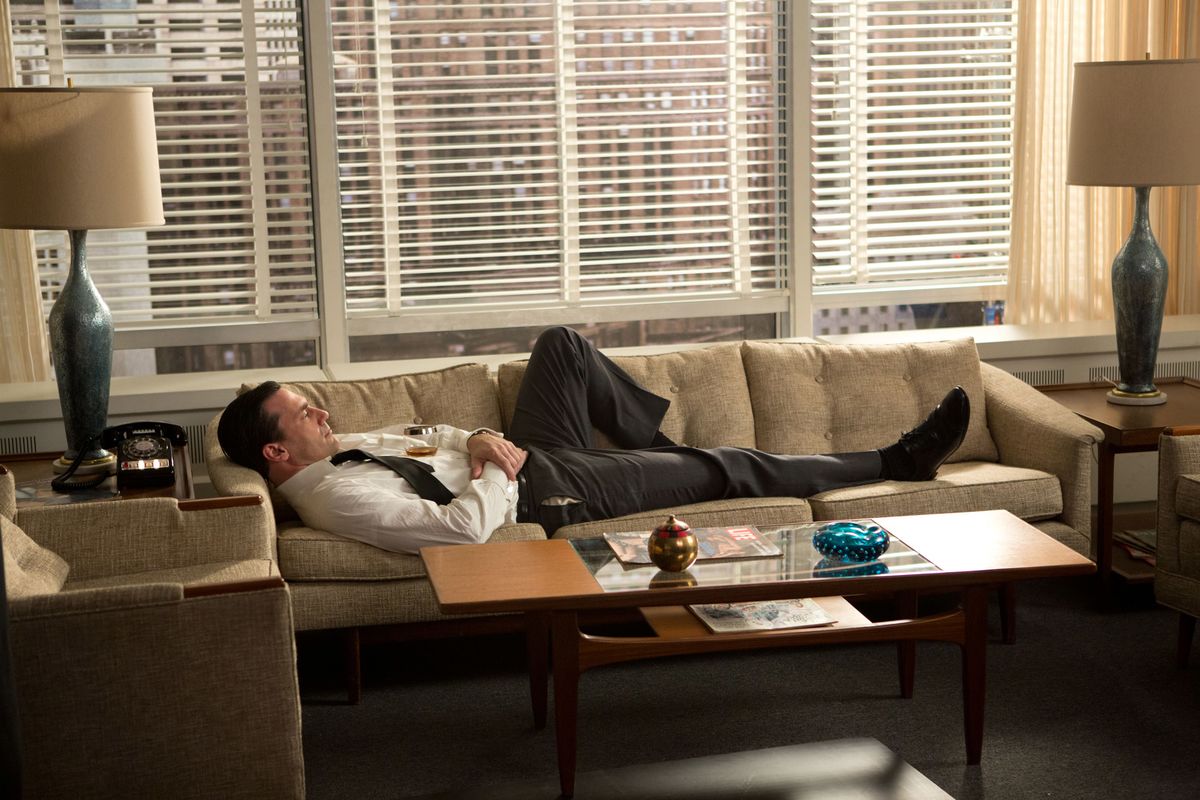
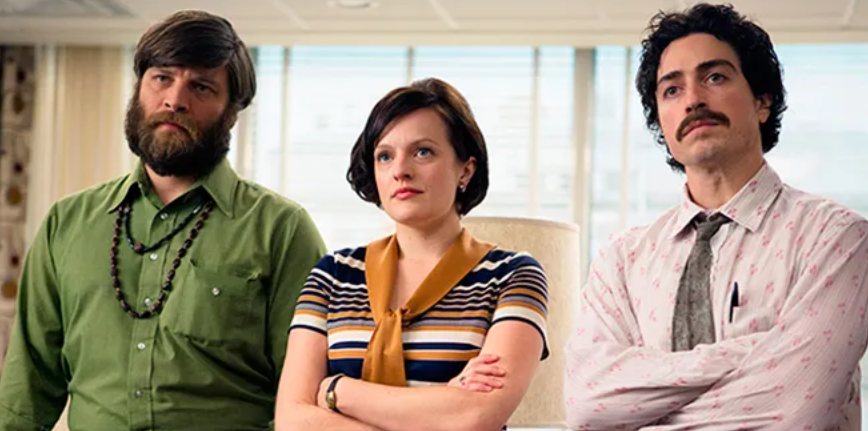
In this, Sterling Cooper's creative laborers resemble the figures of advertising's "creative revolution" in the 1960s, in which copywriters and art directors launched new agencies that resisted the stylistic conventionality and rigid protocols of firms like McCann. Agencies like Doyle Dane Bernach and Papert Koenig Lois valorized ad artistry beyond mere sales effect and encouraged creative laborers to collaborate with far greater autonomy.31 In Mad Men, the creative worker's freedom is marked not just by working conditions but by broader patterns of autonomy — personally, professionally, and in ways that muddy the two. Peggy's decision to place her child up for adoption, though influenced by her unmarried status and estrangement from the child's father, is made immediately following her promotion from secretary to copywriter. For her, the tension between personal entanglement and professional freedom is stark. Likewise, Don's career and personal life are defined by an incessant drive for autonomy — for enough mobility to wriggle free of dependents and the past. He's habitually wiping the slate clean, seeking new connections, shedding old entanglements, as if he could always be change's subject and never its object. He's not exactly a C-Suite bohemian, but there are resonances between Don and those nineteenth-century dandies who, in NSC'sdescription, "possess several lives" and "a multiplicity of identities," who insist on remaining free "from any endowment and rejecting any original debt."32 Initially, McCann serves simply as another subplot of temptation for Don, a professional equivalent to his multiple infidelities. Don sees in the firm a chance to maximize his independence as creative lead for huge clients like Pan Am, but the risks of the second spirit's octopian nature become obvious when Jim Hobart, head of McCann, tries to entrap Don using his wife Betty as a pawn. Roger dissuades Don from accepting the job by arguing against McCann's restrictive management structure and artistic vacuity: "You hear Pan Am, you imagine London, holed up at the Dorchester with three stewardesses. The truth is it's more like a twenty-hour boomerang flight so you can make a coupon sing in Spanish."33
Here arrives the ideological crux: it's a premise central to Mad Men that Don Draper is meant to do more than make coupons sing, but what that "more" is must remain charismatically indeterminate. Despite being marked as inauthentic in almost every other way, Don is — viewers are meant to understand — authentically creative. But what could be more inauthentic than Madison Avenue? The artistic critique during the second spirit valorized its own bohemian authenticity by contrast with the culture industry's massification, typified by the rise of advertising. Indeed, Mad Men frequently affirms advertising's status as a dishonest medium, as when, in the pilot, Don explains, "What you call 'love' was invented by guys like me to sell nylons."34 Yet it simultaneously presents its creative laborers as engaged in genuinely imaginative — indeed, sometimes inspired — work. Rather than reading this friction as a lapse of narrative consistency or insincere double-dealing, we can discern in the show's conflicted presentation a deeper pattern: the dialectic of disenchantment and re-enchantment that, in NSC's telling, animates the field of cultural production under the third spirit. For Boltanski and Chiapello, the commodification of authenticity that defines connectionism is intrinsically contradictory. To meet the threat to its prestige posed by mass consumption's sterility, creative capitalism must draw goods from beyond the commodity sphere, but to traffic in the putatively uncommodifiable is necessarily to mislead, creating "rapid cycles of infatuation and disappointment."35 Worse, as Brouillette argues, this contradiction gets transferred into the figure of "the creative" herself, who must somehow live out the paradoxical belief that "one's distance from market imperatives [will] make one better able to engage in work that would prove both economically and socially productive."36
Creative capitalism's contradictory embrace of authenticity parallels (and perhaps exploits) a lack of semantic closure embedded within the idea of "creativity." Rob Pope summarizes the quandary in two questions: "Is creativity extraordinary: the prerogative of a few individuals who are in some respects exceptional, whether through innate 'genius' or by chance? Or is creativity ordinary: a commonly available, essentially routine capacity latent in everyone?"37 Indeed, the etymology of "creativity" traces its journey from elitist to populist conceptions of making. In its earliest English occurrences, "creation" exclusively named divine world-making before being expanded by eighteenth- and nineteenth-century Romantics to encompass literary and fine art labor. This Romantic conception of creative labor contrasted the (implicitly male) artist's autonomous, market-independent activity with dishonored, impersonal, routinized service work, particularly women's labor. By the mid-twentieth century, "creative" was applied to a wider range of activities, though scare quotes signaled lingering anxieties about misapplication. In recent decades, scare quotes have disappeared, but ambiguity about what is extra/ordinary remains, and perhaps the value of "creativity" in the entrepreneur's lexicon depends on this ambiguity.38
The extra/ordinary semantic tension in "creative" has wily power, retaining much of its religio-Romantic enchantments (charismatic indeterminacy, subjective mastery, authentic expression) yet also encompassing more recent populist conceptions of creativity as problem-solving, an everyday skill available for study and cultivation (which would of course risk regimentation and disenchantment). This newer workaday creativity may resonate with democratic ideals, but it's also pretty useful for getting workers to misrecognize their own alienated labor as forms of personal expression, or at the very least for getting them to reframe their own precarious and ill-paid efforts in terms of what Michael L. Siciliano calls "aesthetic enrollment." In Creative Control, Siciliano presents a rich, empirically grounded theory of the contradictions of labor in contemporary creative industries, drawing on ethnographic fieldwork at a music recording studio and a YouTube management firm. Aesthetic enrollment is Siciliano's term for "object-mediated immersive experiences" by which workers can "feel creative" even while engaged in the most mundane labor for creative industrial firms.39 Thus, our unstable notion of "the creative" — as both outside of and amenable to markets — helps paper over the impossible promise of playful labor and non-commodified commodities, easing capitalism's recovery of the artistic critique. These two related contradictions — the commodification of the non-commodified and the extra/ordinariness of creativity — are central to Mad Men's dramatization of creative labor and its problems. It sometimes portrays its protagonists as having transcended the dialectic of commerce and inspiration, while other times exploiting this same dialectic as its core conflict. "We're gonna sit at our desks and keep typing while the walls fall down around us," Don tells his team in a moment of corporate uncertainty, "because we're creative. The least important most important thing there is" — an apt motto for Mad Men's self-divided presentation of creative labor.
One strand of that presentation is populist, emphasizing creativity's ordinariness via anti-elitist and pseudo-democratic gestures. As mentioned, the series frequently signals its own knowingness about advertising's triviality and guile, a self-mocking sophistication about Madison Avenue its key characters espouse, but it also uses similar gestures of disenchantment to deflate advertising's autonomous other: bohemianism, that supposed storehouse of authentic art-for-art's-sake indifference to commerce. The show's pilot episode gives Don's Byronic allure an edge of unconventionality through his relationship with Midge Daniels, the free-spirited polyamorous artist who pays for her Greenwich Village loft by illustrating greeting cards for Hallmark holidays.40 Don's Madison Avenue job is unquestionably square, but his Village assignations suggest hidden depths. This insinuation of Don's unorthodoxy makes the pilot's concluding twist — his train ride to the spruce suburbs, his night-gowned wife and two sleeping children — strangely inverted. Actually — gasp — he is just a bourgeois conformist after all! Don's scandalous infidelity to Greenwich Village values, though, is quickly used to invert the art/commerce dichotomy. In "Babylon," when Don and Roy Hazelitt (a turtlenecked playwright of "conscious drama") compete for Midge's affections, sharing a table at a Village nightclub open mic, Roy needles Don as old-fashioned and philistine, a fan of the kind of "soulless bullshit" beloved by middle-class season ticket buyers: "I bet Don here can tell you firsthand. Broadway is the birthplace of mediocrity."41 Surveying the dismal open-mic, Don replies: "Maybe it's born there but I think it may be conceived right here." Through such populist swipes at the avant-garde, Mad Men uses its square character's dalliance with the demimonde to undermine bohemia's sovereignty.42
Mad Men's creative populism also flows from creativity's midcentury democratization, which it owes in part to Alex Osborn, the real Madison Avenue figure who invented brainstorming based on idea-generating practices at his agency. Osborn subsequently collaborated with Sid Parnes to develop the Creative Problem-Solving Process, a massively influential theorization and method. Contrary to ideas linking creativity to genius or elite education, Osborn deployed folksy rhetoric about everyday "thinkery" and spoke assuredly of "the creative power within the reach of every man and woman."43 Mad Men presents variations on Osborn's techniques at several points in the series, most notably when brainstorming's implicitly democratizing powers help catalyze Peggy Olsen's move from clerical work to more prestigious creative labor. Viewers witness the powers of Osborn's "thinkery" via the Belle Jolie lipstick brainstorming session of secretaries, who as women and clerical staff, are not expected to be creative subjects. When Peggy surprises with especially good copy — "a basket of kisses," Freddy Rumsen recognizes her talent, reporting: "It was like watching a dog play the piano."44 This moment reveals both the powers and problems intrinsic to Osborn's deflationary, judgment-deferring paradigm: it opens opportunities for overlooked creators but also demystifies and diminishes creativity itself. Seasons later, when Peggy complains an idea is "embarrassing" and "phony," Don reminds her of her status as ordinary: "You're not an artist, Peggy. You solve problems."45
The show's populist cynicism about cultural production sits uneasily alongside its reverential treatment of Don's conference room rhetoric and charismatic indeterminacy. Early in the show's run, Don's salesman shamanism marks him as an extra/ordinarily creative force, a mysterious savant whose medium happens to be advertising.46 Don's new tagline pitch will inevitably do more than wow clients. The idea's unveiling will at first intrigue, then perplex them, before finally overpowering them, touching in them unacknowledged yearnings. The clients will leave the pitch room shaken but cleansed, blinking away a fog that heretofore blinded them to their own product's truth. The moment most clearly marking Don's creativity as extra/ordinary is his presentation for Kodak's Carousel, a pitch blending careful artifice (emphasizing nostalgia over technology) and sublimated autobiographical suffering (Don's grief for his brother and dissolving marriage).47 Even if one finds the pitch inflated and sentimental, Don unmistakably inhabits an extra/ordinary position where creative mystique and commodification converge, where the corporate shill and the tormented artist meet and meld. This is why Jim Hobart so badly wants Don to "bring us up a notch" at McCann.48
If Carousel represents the zenith of Mad Men's commercial/creative synthesis, Don's Hershey's pitch in season six represents its nadir, the moment when the creative shares too much authenticity, breaking enchantment's spell. To "reveal" the commodity as emotional sanctuary, Don again looks for autobiographical inspiration and discloses secrets kept concealed for decades, re-narrating his history with the commodity, including his neglected boyhood in a brothel pick-pocketing johns to pay for Hershey's candies.49 This personal revelation is also a self-immolation. Don is fired and discovers that he himself was the extra/ordinary commodity of his own best pitch: both its subject and object. Here Don's character arc further parallels the historical trajectory of advertising's "creative revolution" in the 1960s. Those agencies pitched themselves as prioritizing creativity over money, ad artistry over client preferences, but ultimately could not transcend market logic, finding themselves undermined by the imperatives that came with equity financing, the price of seeking "autonomy through entrepreneurship."50 Though these "revolutionary" agencies somewhat altered American advertising's aesthetic, they failed to displace any established firms, who simply responded to their challenge by expanding client services and aping the new creative style.51 As with Don, the greatest artistic achievement of these agencies was their own branding, and all brands are fragile.
At least one Mad Men character represents a more hopeful investment in creative capitalism's meritocratic potential. Peggy too is an extra/ordinary creative, demonstrated most clearly when she, rather than Don, leads the presentation to Burger Chef with a layered pitch that reworks in the show's final season what the Carousel pitch did in its first. Both moments of creative labor involve a fictionalized erasure of the line between public and private domains, markets and families, placeless exchange and intimate security. Peggy pitches the fast-food chain as a salve to restore national domestic tranquility. What personalizes the pitch is a bit of autobiographical legerdemain, when Peggy tells the Burger Chef execs, "tonight, I'll go back to my apartment and find a ten-year-old boy parked in front of my TV."52 Mad Men's viewership knows she's referring to her neighbor's son who makes frequent uninvited visits, but the execs assume he's Peggy's child. Shots of Don and Pete's troubled faces add another layer, since both know Peggy gave up her child for adoption nine years beforehand. Their perplexity reminds viewers of the disconnection marking Peggy's parenthood, giving her pitch expressive gravitas. She is verified for both 1960s clients and twenty-first-century viewers as an extra/ordinary creative whose artistry can transform commodities into sanctuaries from the terrifying "change that simply is."
Though Mad Men presents Peggy as the truest avatar of the third spirit, it also uses Don and Peggy's sometimes-exploitative mentorship to open questions that vex creative capitalism. Particularly fraught are questions about unacknowledged contributions, which, given connectionism's premium on collaboration and reputation, pose a genuine menace.53 Peggy leaves Don's agency because he fails to recognize her contribution to a Cleo-winning ad campaign for Glow Coat. If this scenario partially exposes a weakness in connectionism, the edge of critique is blunted by Peggy's ability to move to a competitor and by her ultimate reconciliation with Don. Though connectionism's acknowledgment issue never vanishes, Mad Men is more invested in narrating a decade-long transition from one extra/ordinary creative to another. Peggy's progress also affirms what Nancy Fraser calls the romance of female advancement, which resignifies neoliberal transformations under the sign of feminist ideals.54 Critiquing NSC'sgender blindness, Fraser augments its diagnosis, arguing that capitalism's recuperation of the artistic critique through a "masculinist romance" was paralleled by a new fantasy of female advancement which reframed second-wave feminism's structural critique on individualist grounds, enticing both high-earning women "determined to crack the glass ceiling" and low-wage women workers seeking "material security" and "dignity, self-betterment, and liberation from traditional authority."55 The transformational rise of women's labor force participation in the United States, accelerating most dramatically from the 1960s to the 1980s, coincided with the managerial recuperation of the artistic critique. During this time, on Fraser's reading, a "two-earner" model replaced the androcentric "family wage" model, but this concealed the simultaneous collapse in labor power and prospects. Working hours increased — and pay, security, and living standards all decreased. Feminist critiques of welfare-state paternalism later got repurposed by Margaret Thatcher and Bill Clinton to reduce state action that might have redressed labor's losses. Thus, through the romance of female advancement, "the dream of women's emancipation is harnessed to the engine of capitalist accumulation."56
Though Mad Men often picks apart patriarchal gender norms, it ultimately reiterates the romance Fraser critiques. Peggy's "basket of kisses" moment and the rise it initiates implicitly bolsters the romance of connectionist capitalism and its confidence that the extra/ordinary elect will naturally rise. In the show's finale, Pete tells Peggy, "someday, people are going to brag they worked with you," and predicts she'll be McCann's creative director by 1980.57 Peggy's too-tight smile makes clear 1980 is a long way off, too long to have to wait. Her swaggering entry to McCann — hungover, in shades, cigarette dangling from her lips — strikes a note of heroic defiance both for the unruly forces of creatives over corporate sterility and for the resilience of women pathbreakers over boys'-club brainlessness. But the decade ahead of her is unlikely to be a triumphant one. The story of capitalism's historic crisis and reformation in the 1970s (spiking energy prices, inflation, and declining profits all "resolved" through the Volcker shock and neoliberal governance) has been well elaborated elsewhere. Less remembered is what Shannan Clark calls the period's "cultural deindustrialization," as threats to profitability lead media and advertising industries to tighten belts at the exact moment race and gender-based discrimination began to weaken so that, "as women and minorities finally began to make progress toward equal employment opportunities in the media, overall job prospects deteriorated markedly."58 Let's follow this ellipsis of historical upheaval to consider the 1980s and the evolution of connectionist capitalism through an analysis of AMC's other costume drama of creative destruction, Halt and Catch Fire.
Halt and Catch Fire: The Credit Belongs to Them that Built It
Hyped by AMC as Mad Men's successor when it premiered in 2012, Halt and Catch Fire transported the prestige workplace drama from 1960s Madison Avenue to the 1980s Silicon Prairie, birthplace of Texas Instruments, RadioShack, and Dell. If Matt Weiner used Mad Men to re-narrate the cultural world of his childhood, Christopher Cantwell, one of Halt's co-creators, drew on the experiences of his father, who worked in Texas as a software salesman.59 So obvious were initial parallels between the shows that Joe MacMillan, Halt's corporate antihero with sharp suits and a mysterious past, was dubbed "Tron Draper" in one early review.60 Indeed, Halt's pilot "I/O" can be read as winking acknowledgement of itself as televisual clone expanding the prestige serial market through good old-fashioned intellectual piracy.61 Joe, who shares Don's aversion to the second spirit's corporate gigantism, leaves IBM in 1983 to work for Cardiff Electric, a fictitious firm modeled on Compaq. Shortly after being hired, Joe essentially hijacks Cardiff, goading VP John Bosworth and owner Nathan Cardiff into the growing PC market by reverse engineering the IBM PCjr. He accomplishes this with the help of Gordon Clark, an engineer still nursing ambitions after his own PC startup failed. Joe alerts IBM to his own piracy, forcing his new employer to treat the clone as a legitimate project. This means recruiting out of college Cameron Howe, a punk coding prodigy, to produce a BIOS for Cardiff's own PC, the Giant, thus fueling the PC revolution. The pilot's IP theft may be a clever nod to Halt's own debts to Mad Men, but there are deeper parallels. Both shows dramatize capitalism's recuperation of the artistic critique by tracking a decade of history through the lives of creative professionals. Both romanticize nimble firms as vessels for blending artistic and entrepreneurial energies. And both suggest creative capitalism is incapable of satisfying the desires it conjures.
Halt does more, however, than xerox Matt Weiner's playbook. Though less commercially successful than its predecessor, Halt gained critical praise by pursuing a distinctive project: decentering its male antihero and focusing attention on a female partnership. Where Mad Men's characters are drawn ceaselessly into the past, Halt's are obsessed with futurity. Its characters are a mix of forgotten innovators and copycats inhabiting "the cracks of history," buffeted from Texas to California by tech market upheavals like PC sales, online gaming, early cybersecurity, and internet search.62 Where one can read Mad Men through NSC's three spirits and fascination with creativity, Halt explores specific ideological formations of connectionism's investment in innovation: techno-utopianism, garage inventorship, punk counter-capitalism, and Lean In feminism avant la lettre. Though Halt undeniably romanticizes these four cultural formations, each is treated more skeptically as the series unfolds, raising doubts about the meaning of innovation and about the compatibility of success with personal renewal. "Innovation," declares Joe, is "the only sacred thing in our business."63 Like "creativity," the concept of "innovation" is both essential to contemporary managerial discourse and characterized by semantic tension. Originally used to condemn heretical theological and political views, the word was rehabilitated in the nineteenth century to indicate beneficial technological and economic advancements. Yet key ambiguities remain. The most popular modern usage equates innovation with technical invention, but this differs from the economic definition of innovation — often attributed to Schumpeter64 — which designates the commercialization of technical inventions.65 Is the innovator, in short, one who invents or one who disseminates inventions through markets?66 Near the end of Halt's first season, Bosworth offers an answer implicitly endorsed by the show itself, declaring, "People who put up the money, they like to take the credit, but the credit belongs to them that built it."67 The series places invention and commercialization in persistent tension, normatively endorsing the former but repeatedly staging the victory of the latter amid Schumpeterian destruction and rebirth.
Halt's clearest embodiment of commercialization (as distinct from invention) is Joe, a sales exec with no coding or engineering chops, who is, as Gordon sneers, "one of those idea people" who's "never actually been close to the metal."68 Joe initially exudes the slick psycho-in-a-suit ethos of Gordon Gekko and Patrick Bateman, but MacMillan is an ardent believer, not a nihilist. Though he doesn't trade his suits (fig. 7) for dark turtlenecks and leisure wear (fig. 8) until later seasons, Joe is quickly marked as an ersatz Steve Jobs, another avatar of the "heterogeneous orthodoxy" accompanying the advent of digital capitalism critiqued by Richard Barbrook and Andy Cameron as the "Californian Ideology." Anticipating NSC's analysis, Barbrook and Cameron's 1996 essay skewered its titular ideological formation, which "promiscuously combines the free-wheeling spirit of the hippies and the entrepreneurial zeal of the yuppies."69 This unlikely synthesis fused formerly antagonistic social forces of the 1960s — Governor Reagan and Bay Area beatniks — "through a profound faith in the emancipatory potential of the new information technologies" and "through a nearly universal belief in technological determinism."70 Indeed, the ideology's success is predicated on "the very ambiguity of its precepts," the most pronounced being its "contradictory visions of the digital future": simultaneously a McLuhanite electronic agora and digital free market.71
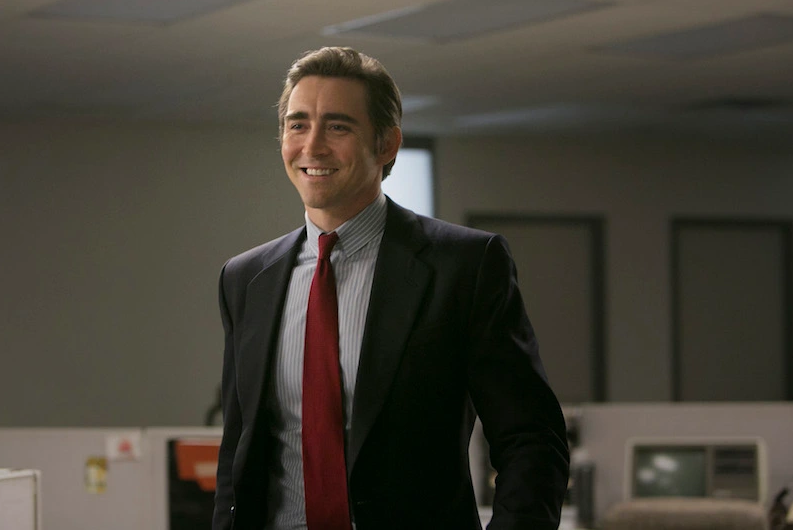
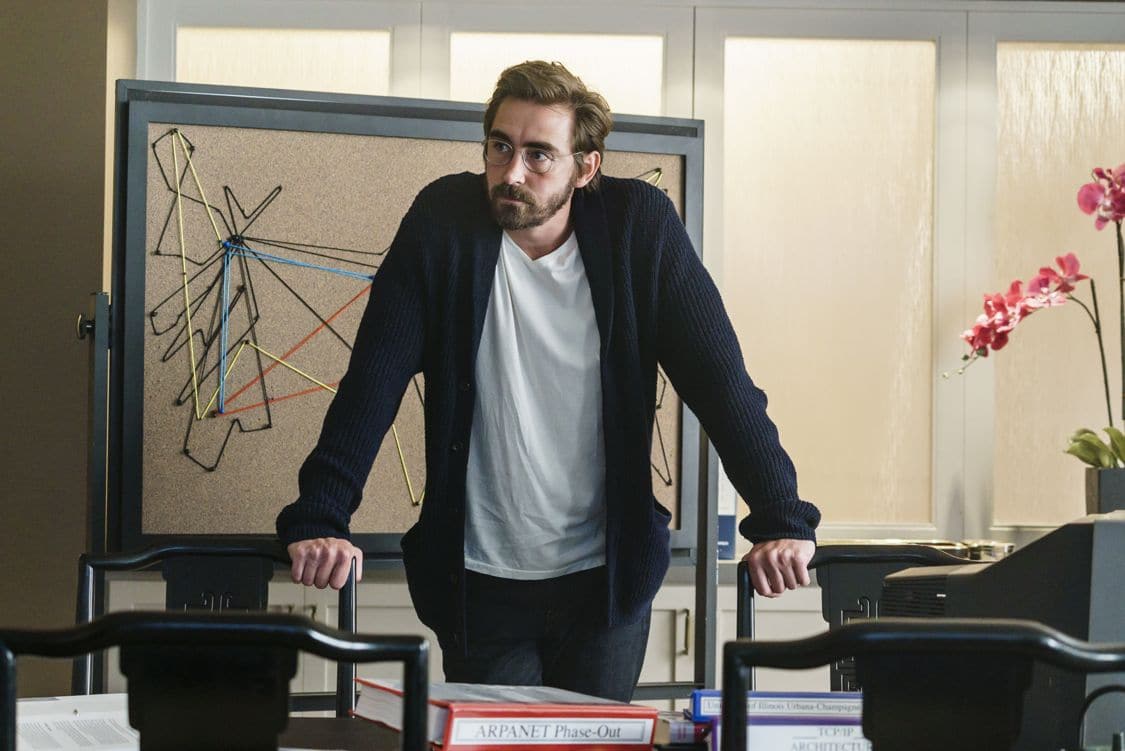
Joe's parentage underscores this synthesis: half Berkeley dreamer, half Reaganite fat cat. Joe's mother was a countercultural figure who, during a period of drug experimentation, took her son on a roof to stargaze and let him fall three stories, causing years of hospitalization and permanent scarring. Joe's father — an IBM executive and second-spirit planning engineer — seized the child, lying to him that his mother had abandoned him and subsequently died. This mixed parentage telegraphs the social inheritances that we are meant to understand contend within and culminate in Joe, whom Halt rarely presents without some measure of irony (a fact lost on many reviewers). In a pep talk to Cardiff's engineers, Joe promises that "we just might change the way people work, the way people live, and how they interact with each other. We just might put a ding in the universe." When Gordon points out the "ding in the universe" line is cribbed from a recent Steve Jobs interview, Joe grins: "Yeah, I know. Isn't it great?"72 Joe can plagiarize stratospheric promises without shame because he believes them. In this fusion of cynicism and self-belief, Joe recalls that phenomenon so characteristic of tech development: vaporware, the practice of bluffing products into existence that was a consistent part in the rise of Bill Gates among others.73 Early reviewers complained that Joe's characterization was disjointed, fragmentary, changing in purpose scene to scene, but this missed how Joe functions as a chiasmatic figure condensing the truth that Steve Jobs was PT Barnum and vice versa. Indeed, Barnum, "Prince of Humbugs" and entertainment-sector innovator, is a key reference. By having Joe and Gordon call their PC clone the "Cardiff Giant," Halt undercuts Joe's impassioned messianism by recycling the name of one of Barnum's most famous hoaxes.74 Those who watched Halt's early episodes assumed Joe's bluster was intended to rouse engineer and audience alike, but more careful analysis makes clear that Joe embodies the bait-and-switch commercialization endemic to the tech sector, the incongruity between its messianic techno-utopian promises and the kludgy artifacts it often delivers. Connectionism promises to wed art and entrepreneurship, but this means there's little distance between artist's dream and huckster's hoax.
If Halt dramatizes the Californian ideology's false promises through Joe, it dissects a comparable ideological formation — the romance of the garage start-up — through Gordon Clark (fig. 9 and 10).75 Playing the corporate Mephistopheles, Joe identifies, targets, and uses Gordon, who languishes as a computer engineer at Cardiff Electric after a defeated effort at entrepreneurship. Years prior, Gordon and his wife Donna, now an engineer at Texas Instruments, had designed and built their own PC, the Symphonic, which flopped at the COMDEX trade show. Joe revives Gordon's stalled ambitions at work and partners with him for a weekend of IP piracy. While Donna and daughters are away on a vacation, the men work in Gordon's garage with an oscilloscope to dump the PCjr's BIOS and manually write out its 65,000 hex values. This improbable method of reverse engineering justifies a montage of gleeful male gearhead partnership, the mainstay of tech's romance of the garage. Where the Californian ideology makes utopian promises about technological commercialization, the garage is a corollary space of invention, one that suburbanizes the dream of unalienated labor. Recognizing this utopian element need not obscure the historical specificity of the garage topos and the hierarchies it mediates. The space's conspicuous humility is a subterfuge. The genius tinkerers — in these legends always otherwise middling white men — dream in a setting not wholly domesticated, not quite integrated into the adjoining feminized home. There, men imagine tomorrow's machines in the space where today's machines are stabled and maintained, so that information technologies become linked to the gender politics of the automobile, with its overtones of masculinity, mobility, and freedom.
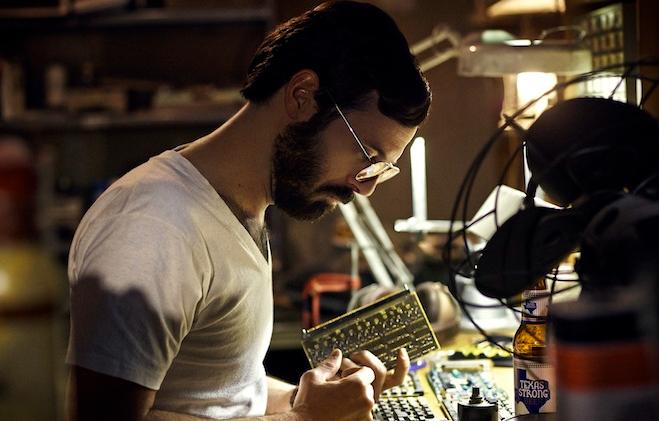

This garage topos constitutes a genre of capitalist folklore where cooperation, creativity, and capitalization are merged, fortunes are built, and the world is changed. It's a testing ground for auteur entrepreneurship. The dominance of the garage startup topos sidelines aspects of the tech revolution that do not fit the connectionist narrative.76 In this respect, the garage functions as an ideological myth, a tech equivalent to the Jeffersonian farm. It's the seat of private male invention, where white men's gumption, tinkerer's know-how, and undomesticated play somehow alchemically transmute into profit and global transformation. Halt indulges this myth in its pilot, though not uncritically. Returning to find Gordon and Joe sleeping off their clandestine crime, Donna chides Gordon for lying and risking his job security reliving old dreams: "I guess I never had the burden of believing that I was some misunderstood genius."77 Gordon, it's clear, is not a misunderstood genius; he's an IP pirate, a plagiarist like Joe. His garage, like many before it, is a site of imitation as much as invention. As Halt progresses, it sidelines Joe and Gordon and the forms of grandiosity they represent. Their copycat Cardiff Giant is itself copied and made profitable only after Gordon destroys Cameron's innovative but memory-hungry BIOS. This betrayal moves Cameron to team with Donna and create a new venture, Mutiny, a gaming start-up and online community that serves as a punk negation of both Joe's duplicitous commercialization and Gordon's suburban romance of garage-bound invention.
Through Cameron and Mutiny, Halt explores the utopian possibilities and internal contradictions of punk's resistance to capitalism. In his materialist investigation into punk subculture, Stacy Thompson argues the "entire field of punk can be understood as a set of problems that unfold from a single contradiction between aesthetics and economics," a contradiction that's unavoidable since punk "never assumes its place as a commodity proudly but only with resistance and through mediation, as well as with mistrust and skepticism."78 In order to "mediate between the felt antagonism between use- and exchange value" unfolding in the conflict "between the aesthetic and economic spheres," punks employ a range of practices to cope with "the shame of exchangeability," particularly strategies favoring "nonreproducible commodities and unalienated labor."79 This wider context of value-conflict helps to illuminate Cameron's specific relation to tech enterprise, invention, and commercialization. Her identity as a punk is telegraphed through soundtrack selections, often played diegetically at high volume through her Walkman (fig. 11). Alongside expected UK punk tracks like X-Ray Spex's "Germ Free Adolescents" and The Clash's "The Magnificent Seven" appear cuts from lesser-known punk groups of the 1970s and early 1980s from southern California (The Vandals, The Weirdos) and Texas (Nervebreakers, Big Boys).
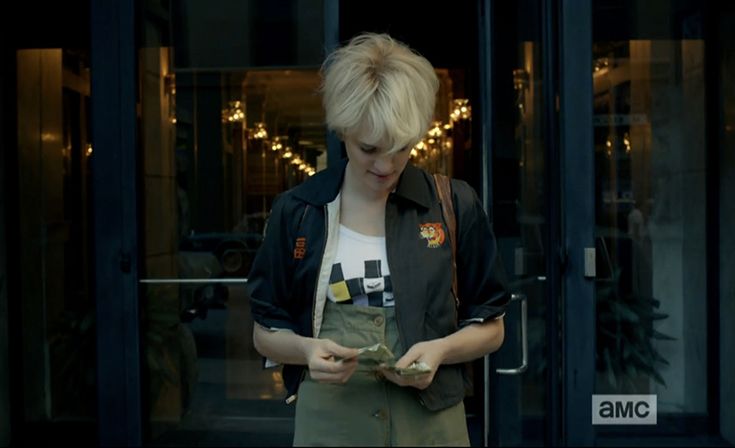
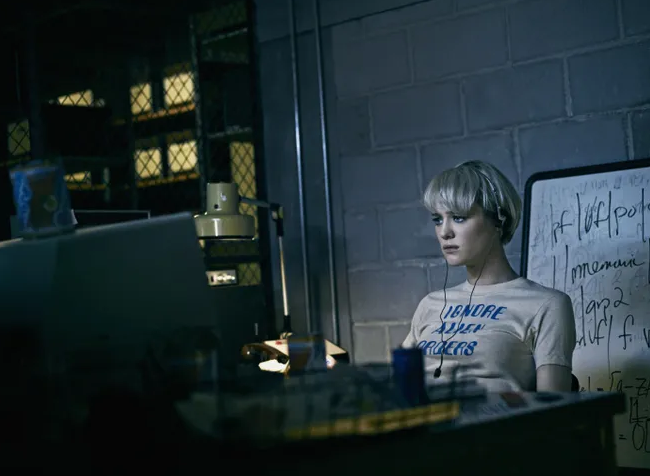
The music selections surrounding Cameron signal time, place, and subcultural affinity, but their lyrics also provide a chorus of punk commentary — often though not always disapproving — on her growing entanglements with the world of commerce. Cameron is accompanied on her first day as a programmer at Cardiff by "The Magnificent Seven," which ridicules the grind of a low-wage workday.80 Cameron mocks Joe's conman motivational speeches to programmers — "Have fun, make money" — while her headphones play Bad Brains "Pay to Cum," a song balancing the disillusionment of discovering universal commodification with the more defiant hope of art asserted beyond commerce.81 Throughout the first season, Cameron uses songs like Really Red's "Too Political?" and The Dicks' "Rich Daddy" to drown out the corporate spaces in which she finds herself, countering slick commerciality with lyrics like, "White collar crime is justified with money / While too many people starve in this land of milk and honey."82 Most pointedly, when Cameron receives her first corporate paycheck and goes shopping (fig. 12), her soundtrack is "First Time" by The Boys, a rollicking song about a young girl losing her virginity, connecting punk's ambivalent engagement with commerce to the mingled thrill and shame of sexual initiation.83 These songs narrate Cameron's seduction into commercialization, a seduction ending in duplicity. After her innovative BIOS is betrayed by Joe and Gordon, Cameron is confronted by "the shame of exchangeability," leading her to create Mutiny, a gaming enterprise with a punk ethos that prioritizes invention over commercialization.
Mutiny's quasi-frat-house space where programmers eat, game, and code is an intriguing punk revision of the garage's politics. If the garage is a suburban space of partnered tinkerers, Mutiny is closer in spirit to a squatter commune. The garage's whiteness and petit bourgeois insularity are countered by Mutiny's more racially heterogenous rental house.84 While most Mutiny coders are men, they're not visionary heroes; they're geeky man-children unable to modulate diets, sleep cycles, or wardrobes in a domestic but undomesticatable space. The visionary heroes are women — Cameron and Donna — who lead by example, first pioneering the creation of text adventure and first-person shooter gaming then — thanks to Donna — moving on to blaze trails in online chat and internet trading. As workplace and site of invention, Mutiny evokes the utopian possibilities of punk counter-capitalism with its DIY philosophy, anarchic resistance to commodification, and embrace of collective creativity. It's a sneering retort to the shame of exchangeability. Cantwell and Rogers are fascinated with Mutiny as an enterprise model, but they subject it to narrative tests that reveal punk's limitations as a form of anti-capitalism. Cameron professes a managerial anarchism, rejecting hierarchical control. She tells her gathered coders, "I'm not your boss. Nobody here has titles. Your title is your first name. [. . . ] Also, this isn't my thing. This is our thing. Which means you'll get out of it exactly what you put into it. For me, it's everything. For all of us, it should be everything. Otherwise why even do it at all?"85
While nominally bossless, Mutiny is no worker's paradise. Tellingly, Cameron's speech resembles the sort of "antimanagement" managerial rhetoric observed by Michael L. Siciliano among present-day supervisors of creative laborers, typified by one tech company hiring manager who similarly declared: "Titles, titles, I'm bad with those."86 Cameron's assertion that Mutiny "should be everything" for "all of us" is also revealing. As NSC notes, the erased boundary between work and life that defined the nineteenth-century artist's authenticity becomes, under connectionism, a dissolution marking the lives of all.87 If the boundary between work and leisure was pleasantly blurred at Sterling Cooper, it's abolished at Mutiny. Industrial time-discipline becomes irrelevant, but workers are not freed from the commodification of their time: they are completely subjected to it. There's no border between work and leisure because there's no leisure, and Mutiny hardly offers security in return. When the company's subscription revenue drops, Cameron tells her devs that, although they have been "busting their asses," the company can only cover operating expenses, not salaries. In exchange for forgoing income, they're offered company shares that will, Cameron assures, be worth more over time. Most of the crew stay on for stock pay, which ultimately proves worthless.88 Mutiny's call to punk innovation thus resembles the dispositif identified by Angela McRobbie: "the imperative to 'be creative' is an invitation to discover one's own capabilities, to embark on a voyage of self-discovery" in which "insecurity is seen as part of the adventure."89 Cameron's managerial anarchism also undermines her partner Donna, who joined Mutiny because her husband sidelined her ambitions and engineering talents, only to be confined to playing den-mother and realist nag. Cameron's insistence on punk counter-capitalism is an individual, not a shared, choice; Mutiny's punk fiefdom brings tyranny not anarchy. The collective enterprise retains the exploitative elements of the corporate hierarchies it rejects. Thus, the show's investment in Mutiny's feminist ethos and Musketeers-style teamwork belies its implicit critique of the anarcho-capitalist alternative it represents.
Donna Emerson (née Clark) and her ascent to the heights of VC partnership represent Halt's last connectionist formation: the kind of neoliberal recuperation of feminism presented in former Facebook COO Sheryl Sandberg's Lean In. That bestseller enjoined women to "reignite the revolution by internalizing the revolution" and fill the "leadership ambition gap."90 Catherine Rottenberg critiques this influential program in an analysis that builds explicitly on Fraser, arguing against this revision of feminism through which "the question of social justice is recast in personal, individualized terms," a feminism whose subject "is not only individualized but entrepreneurial," who must "optimiz[e] her resources through incessant calculation, personal initiative, and innovation," all while "calibrating a felicitous work family-balance."91 If Peggy Olson has to wait until 1980 for her creative triumph, Donna breaks the glass ceiling while she's young, though the trajectory remains the same: a side-lined woman (fig. 13) gradually achieves individual career success (fig. 14) despite systemic corporate sexism.
Until Halt's final season, Donna's ambitions are subordinated in a sequence of overt and covert partnerships.92 Supporting Mutiny's romance of innovation imposes severe strains on Donna's domestic identity, and the show tracks her unhappiness as a parent, her marriage's disintegration, and the unwelcome pregnancy she secretly aborts. Marginalized by Cameron and resented by Gordon, Donna finds a new partner in Diane Gould, a pant-suited venture capitalist who helps Mutiny acquire a competitor. Donna is compelled by Diane's superwoman status (successful parent, feminist executive, and bearer of baronial wealth) and, in her conflicts with Cameron, begins emulating Diane's cold-eyed market orientation before finally joining Diane's VC firm as a partner after Mutiny's failed IPO in season three. Donna — the most beleaguered and sympathetic character for the first three seasons — becomes an ambiguous antagonist in the fourth: a brittle, alcoholic character isolated in gilded spaces, sniping at underlings, and competing against her own daughter's program. The change in sympathy is due partly to Donna's shift from invention to commercialization, from "those that built it" to "those who put up the money." In the show's finale, Donna is given a feminist rehabilitation, throwing a party for women in tech and telling the poolside gathering that "even if we see each other across the corporate battle lines one day . . . you will know that I am rooting for you. . . . Because I am a partner by trade, and a mother and a sister by design."93 The speech — presented as a stirring summation of Halt's saga — encapsulates Lean In neoliberalism's sublimation of gender solidarity through the individual paths permitted by the market.
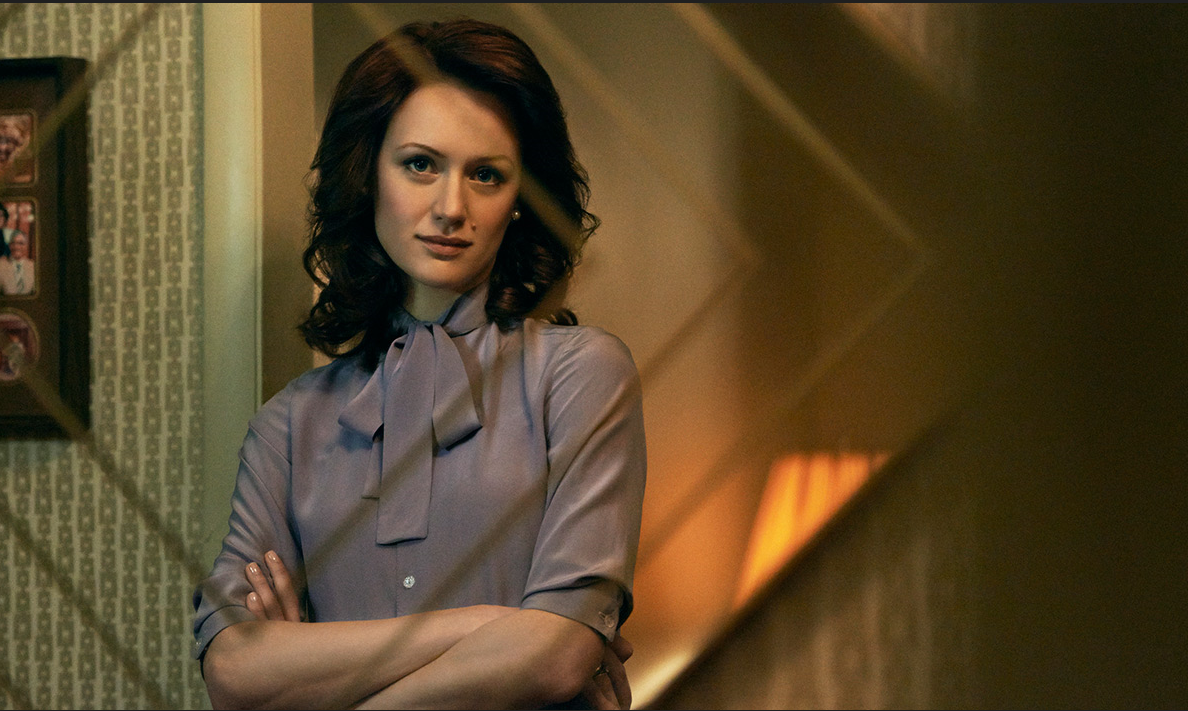

Underneath this suggestion of feminist progress, a bleaker temporality lurks: the relentless and ravenous impersonality of competition and failure that innovation demands. In its early seasons, Halt presented cycles of commercial death and rebirth with a sense of guarded hope, as with the rebounds of Gordon after the Symphonic's failure and of Cameron following the betrayal of her BIOS. These failures were entrepreneurial phoenixes leading to brighter rebirths. One figure for this recurrence is Cameron's program Pilgrim, a quest game with open-field exploration that resets to the beginning when you fail any of its puzzles. Bosworth complains, "Hell, it's like you can't even win," but Cameron says this guarantee of failure — and the eternal recurrence of gameplay — is part of the point: "now you can approach the path you take in an entirely new way." 94 This response may suggest a Zen investment in process, but because Halt's viewers watch cycles of commercial rebirth repeat incessantly, such looping restarts begin to feel like capitalist samsara, a transmigration across markets and platforms that is both aimless and unredemptive.
This bleaker view of innovation's loop is made explicit when Joe contemplates San Francisco as a place of transience and impermanence. The whole city "burned down seven times in the first couple years of its existence," shedding old buildings and names, and, in the show's period, the AIDS epidemic is killing tens of thousands there and threatening Joe directly. Ryan, Joe's programmer, sees the city's impermanence as an opportunity: "You can screw up, you can fail, and so what? You get another chance." Joe, who's already rebuilt his career and persona three or four times, is more contemplative about decline and rebirth, and "can't decide if it's beautiful or horrifying."95 Even Donna's triumphant poolside speech is haunted by innovation's endlessness: "no matter what you do, somebody is around the next corner with a better version of it. . . . And sometimes, that person is you. The you that's never satisfied with what you just did, because you're obsessed with whatever is next."96 What Joe and Donna are glimpsing is creative destruction after one's sense of calling fades, a state of Sisyphean unrest. Profit and reinvestment churn with an alien automaticity, with no objective higher than greater churning and reinvestment. This circularity is part of what William Sewell calls capitalism's "hyper-eventful but monotonously repetitive" temporality."97 In any given moment, its movements are feverish: bankruptcies, bubbles, whole industries plunge into obsolescence, with its subjects driven to "repeatedly rethink the assumptions of their social existence." Yet, in capitalism's core processes, there remains a grinding circularity, an endless pursuit of accumulation for accumulation's sake that's "like running on a treadmill" perpetually. Both restless and inexorable, frantic and unchanging, this temporality gives capitalism a "nihilistic tendency that is alternately or simultaneously liberating and terrifying."98
NSC shows that connectionism fails to fulfill its key promises in recuperating the artistic critique. Dissolving the opposition between artist and industrialist translates bohemian autonomy into labor insecurity. The thirst for authenticity gets temporarily placated through product differentiation, and the liberation on offer is emptied of any oppositional charge. For much of its run, Halt's protagonists seem caught in the dream of temporal transcendence, chasing a connectionist future of shared innovation and personal liberation. By its final episodes, the dramatic question becomes whether the characters can escape this endless repetition, this incessant seriality, reverting to a state where, as Gordon complains, "Most of us in the human race, we don't get to know what comes next. We just feel shit as it's thrown at us."99 Shortly after deciding to relaunch his last business, Comet, as a web portal, Gordon dies of a stroke. Joe and Cameron try resurrecting Comet, but Yahoo! swamps them. Cameron and Donna imagine launching a new firm ("Phoenix") together again and doing it right this time — growing at their own speed, devoting two years to R&D. As their daydream develops, they describe repeating every Mutiny concession: joining with a bigger firm, abandoning their culture, laying off staff, until "soon enough, the decision got made for us."100 This shared daydream, this fictitious enterprise's fate, necessarily affects how viewers interpret the finale's concluding montage, in which Donna develops an idea for another business venture with Cameron and the two drive into the sunset, chasing a future that can never arrive. Joe abandons tech to teach humanities at a prep school, announcing to his pupils, "Let me start by asking a question," repeating verbatim his first line from the pilot's opening scene. Back then, Joe asked Cameron's college class to "tell me one thing that will be true about computers ten years from now." A decade older, Joe the techno-utopian wants to forget about computers and the future altogether.
Conclusion: Look, Something New
Mad Men and Halt's shared fascination with connectionism extends beyond the screen and can be linked to the conditions of their own production and reception. The dramatic increase in "quality" scripted television from the turn of the century to the present has prompted extensive academic commentary. That wave of content creation bound up with both advances in media distribution technology and audience fragmentation is best charted by Rogers, Epstein, and Reeves, who map television's changing political economy under the rubrics TVI (1960-1980, broadcast, risk-averse, formulaic, and Fordist), TVII (1980-2000, broadcast and cable, increased competition, audience targeting, channel branding, with experiments in "quality" tied to audience segmentation), and TVIII (post-2000, multiplatform transmission, subscription models, asynchronous viewing, and crowded fields of production).101 Mad Men is a defining TVIII pioneer that its network used — as Jim Hobart used Don — to "bring us up a notch."
AMC's transformation from "the not-good Turner Classic Movies" to the network that stole HBO's Peak TV thunder was managed by Josh Sapan and Rob Sorcher, who set course in 2002 by deciding ratings didn't matter.102 As reported in Brett Martin's Difficult Men, Sapan "was afraid that, in the digital age, a world of consolidation, the network was just going to drop into oblivion."103 To avoid being relegated out of cable packages or acquired cheaply by a conglomerate, they sought to produce a complex serial loss leader — their own Sopranos — a show that would be adored by the press and adorned with Emmys.104 Shaking off the déclassé air of basic cable required anti-commercial choices, since prestige mattered more than viewership. Were it not for these circumstances, they would never have greenlit Weiner's much-rejected script whose unmarketability Sorcher summarized: "Everyone smokes. They're unlikable. It's about advertising — there's no international value in that. It's slow. It's period. It's the worst idea ever."105 Tellingly, AMC anchored its promotion campaign for this prestige loss-leader not to its attractive cast but to Weiner and his Sopranos affiliation. They were, in Brett Martin's words, "claiming auteurship as its brand," a phrase encapsulating the connectionist ethos Mad Men dramatizes.106
Weiner's efforts to produce TV as a cinematic artform, not a debased secondary commodity, instantiate the connectionist hope of melding commerce with art. A work of collaborative artistic labor that is also a monetized piece of corporate IP, Mad Men is itself an extra/ordinary product. As Michael Szalay argues, the show is also about its own making, with both Don Draper and Matt Weiner leading creative teams within contexts understood to be crassly commodified, an instance of "industrial reflexivity" that "expresses a fantasy about what it means for writers to become the creators and showrunners of their own quality projects."107 The travails of Sterling Cooper's creative lounge — its fragile comradery, its unequal distributions of effort and reward — mirror the dynamics of Mad Men's writers' room collaboration with its hierarchies of prestige and recognition, its disputes over authorship and ownership.108 Whereas Draper and Olson sell smokes and beans by charging them with interpersonal affect, prestige dramas like Mad Men confer status on their platforms by flaunting literary influences, embracing arthouse techniques, and signaling artistic autonomy through anti-commercial gestures, like Weiner's refusal to edit for commercial breaks. Mad Men — and the genre of prestige TV drama that it helped to engender — exists at the intersection of small-scale and large-scale fields of cultural production. By contrast, Halt, like its belated protagonists, is an also-ran struggling to stand out amid dizzying waves of innovation and imitation.
There are additional suggestive correlations between the stories these programs tell and their conditions of production and reception. That they allegorize their own auteur entrepreneurship makes them well-suited to mediate the fantasies and anxieties of their knowledge-worker viewerships, who also endure the risks of unmarketable authenticities, unacknowledged collaborative contributions, IP insecurity, and increasingly dense competition. The backlash occasioned by Obama's political ascendency among rustbelt working-class whites has been exhaustively analyzed. Less examined has been how the icon of spectacular Black eliteness shaped the self-understanding of the white middling sort — liberal, collegiate whites with cultural capital of declining value. How did such populations — a small fraction of which constituted the viewership of these two shows — make sense of Mad Men and Halt's historical images of prosperous whiteness as worsening economic conditions brought precarity at last from long-shuttered factories and vacant lots to the doors of their townhouses?
It was more than marketing and word of mouth that gave Mad Men its cultural resonance, charting as it does the lives of cultural and managerial elites from a historical moment of uneasy (and often unearned) wealth and security to a moment of disintegration and upheaval. The show's trajectory of wavering confidence and dissolving security fitted its time perfectly. Mad Men's later seasons — and all of Halt's four-season run — are haunted by the specter of widespread precarity that emerged during the 2007-2008 systemic crisis and the home foreclosures, bankruptcies, and grinding recession that followed. Amid these upheavals, did connectionism's promise finally fade for good? The narrative resolutions of both programs suggest a waning faith in that promise, a turning from ambivalence to critique and a recognition of the impossibility of lasting autonomy within roiling markets that promise liberation.
The costume dramas of creative destruction cast attention back into the past, showcasing bygone styles and remembered headlines, mixing nostalgia, self-congratulation, and critique. They offer novelistic presentations of whole decades of recent socioeconomic history. But, looking back from a post-peak TV moment, such ambitions already seem slightly dated. The glut of prestige productions has paradoxically returned TV in the streaming era to earlier dynamics of disposability, and crowded fields of production add new shows of increasingly ordinary "quality" to an ever-larger glut of prestige programming. The Second Golden Age of TV — perhaps even the era of connectionism itself — may already be old news. What finally sets these shows apart is their elegiac self-awareness of this fate, presenting as they do tableaux of anxieties about the evanescence of creative labor in a culture forever forgetting forward, where each crest of innovation hides a receding backwash of obsolescence.
Aaron Chandler is associate professor of English at Stevenson University in Maryland.
References
- For example, Sam Rafuse, "10 Marketing Lessons from Mad Men and Don Draper," LinkedIn, May 19 2015. Blake Crosley, "Career Insights from Don Draper" ZipRecruiter, Apr. 5, 2013. Frances Bridges, "Best Advice from 'Mad Men'" Forbes, May 31, 2015. Brittney Morgan, "10 'Mad Men' Quotes To Live By at Work." Business News Daily, Apr. 9, 2015. [⤒]
- See Ulrich Bröckling. The Entrepreneurial Self (London: Sage, 2015). [⤒]
- Mad Men, season 3, episode 2, "Love Among the Ruins," aired August 23, 2009, on AMC. [⤒]
- Ibid. [⤒]
- Michel Foucault, The Birth of Biopolitics, trans. Graham Burchell(New York: Picador, 2003), 226. [⤒]
- Mad Men, season 1, episode 13, "The Wheel," aired October 18, 2007, on AMC. [⤒]
- Joseph Schumpeter, Capitalism, Socialism, and Democracy (New York: Routledge, 2003),124. [⤒]
- Richard Florida, The Rise of the Creative Class (New York: Basic, 2002), 39. [⤒]
- Ibid., ix. [⤒]
- Angela McRobbie, Be Creative: Making a Living in the New Culture Industries (New York: John Wiley & Sons, 2018); Mark Banks, Creativity and Cultural Policy (New York, Routledge, 2014); Sarah Brouillette, Literature and the Creative Economy (Stanford: Stanford University Press, 2014). [⤒]
- Brouillette, Literature and the Creative Economy, 6. [⤒]
- Drawing on both labor history and an empirical examination of management-theory discourses directed at those who execute capitalism on the ground, NSC surveys a set of sixty management manuals published in France and the United States between 1959 and 1969, then analyzing that dataset against a second set of sixty manuals published in the 1990s. [⤒]
- Ibid., 326. [⤒]
- In mapping Mad Men to historical formations of capitalism, I follow David Pierson in Analyzing Mad Men: Critical Essays on the Television Series (Jefferson: McFarland, 2011), 79-94. [⤒]
- A brief reading of Mad Men and Halt anticipating my own occurs in McKenzie Wark, Capital Is Dead: Is This Something Worse? (New York: Verso, 2021), 44. Applying her theorization of the class conflict between hackers (who provide new information) and vectoralists (who own the vector of information), Wark contends both shows "hinge on the desire to escape from the hacker class and become owners," but I think her claim that ownership is "the limit to the yearning the culture industry can permit for this class" is too absolute, underplaying the ambivalences and elements of reflexive critique in both shows. [⤒]
- Brouillette, Literature and the Creative Economy, 13. [⤒]
- My reading of the politics of consuming history through these two programs is indebted to Jerome de Groot, "'Perpetually Dividing and Suturing the Past and Present': Mad Men and the Illusion of History," Rethinking History: The Journal of Theory and Practice 15, no. 2 (May 2011): 269-285. [⤒]
- Mad Men, season 3, episode 13, "Shut the Door. Have a Seat," aired November 8, 2009, on AMC. [⤒]
- Luc Boltanski and Eve Chiapello, The New Spirit of Capitalism, translated by Gregory Elliott, Reprint edition (London: Verso, 2018), 10. [⤒]
- Mad Men, season 2, episode 5, "The New Girl," aired August 24, 2008, on AMC. [⤒]
- Mad Men, season 3, episode 6, "Guy Walks into an Advertising Agency," aired September 27, 2009, on AMC. [⤒]
- Mad Men, season 7, episode 11, "Time & Life," aired April 26, 2015, on AMC. [⤒]
- Mad Men, season 1, episode 4, "New Amsterdam," aired August 9, 2007, on AMC. [⤒]
- Mad Men, season 6, episode 10, "A Tale of Two Cities," aired June 2, 2013, on AMC. [⤒]
- Boltanski and Chiapello, The New Spirit of Capitalism, 18. [⤒]
- John Kenneth Galbraith, The New Industrial State (Boston: Houghton Mifflin, 1967); James Burnham, The Managerial Revolution (New York: The John Day Company, 1941). [⤒]
- Mad Men, season 6, episode 8, "The Crash," aired May 19, 2013, on AMC. [⤒]
- Shannan Clark, The Making of the American Creative Class (New York: Oxford, 2021), 310. [⤒]
- On Mad Men's treatment of workspace and leisure, see Patrice M. Buzzanell and Suzy D'Enbeau, "Explicating Creativity and Design: The Nature and Meaningfulness of Work in Mad Men," Western Journal of Communication 77, no. 1 (2013), 54-71. [⤒]
- Mad Men, season 4, episode 9, "The Beautiful Girls," aired September 19, 2010, on AMC. [⤒]
- Clark, The Making of the American Creative Class, 312-313 [⤒]
- Boltanski and Chiapello, The New Spirit of Capitalism, 434. [⤒]
- Mad Men, season 1, episode 9, "Shoot," aired September 13, 2007, on AMC. [⤒]
- Mad Men, season 1, episode 1, "Smoke Gets in Your Eyes," aired July 19, 2007, on AMC. [⤒]
- Boltanski and Chiapello, The New Spirit of Capitalism, 445. [⤒]
- Brouillette, Literature and the Creative Economy, 13 [⤒]
- Rob Pope, Creativity: Theory, History, Practice (New York: Routledge, 2006), 53. [⤒]
- The extra/ordinary division animates much of the robust social scientific literature on creativity. See James C. Kaufman and Ronald A. Beghetto, "Beyond Big and Little: The Four C Model of Creativity," Review of General Psychology 13, no. 1 (2009): 1-12. [⤒]
- Michael L. Siciliano, Creative Control: The Ambivalence of Work in the Culture Industries (New York: Columbia, 2021), 87. [⤒]
- See Michael Szalay, "The Writer as Producer; or, The Hip Figure after HBO," in Mad Men, Mad World: Sex, Politics, Style, and the 1960s, ed. Lauren M. E. Goodlad et al. (New York: Duke University Press, 2013), 121. [⤒]
- Mad Men, season 1, episode 6, "Babylon," aired August 23, 2007, on AMC. [⤒]
- In reading Midge as part of Mad Men's "general foreclosure of mad inspiration" in the form of bohemian experimentalism, I follow Dana Polan, "Maddening Times Mad Men in Its History," in Mad Men, Mad World, 48-49. [⤒]
- Alex Osborn, Your Creative Power (New York: Scribner, 1949), 2. [⤒]
- Mad Men, season 1, episode 6, "Babylon." [⤒]
- Mad Men, season 3, episode 2, "Love Among the Ruins." [⤒]
- For a critique of Draper's putative brilliance, see Kevin Craft, "Why Does Everyone on 'Mad Men' Call Don Draper a Creative Genius?" The Atlantic, March 19, 2012. [⤒]
- Mad Men, season 1, episode 1, "Smoke Gets in Your Eyes." [⤒]
- Mad Men, season 1, episode 9, "Shoot." [⤒]
- Mad Men, season 7, episode 7, "Waterloo," aired May 25, 2014, on AMC. [⤒]
- Clark, The Making of the American Working Class, 314 [⤒]
- Ibid., 316-317. [⤒]
- Mad Men, season 7, episode 7, "Waterloo." [⤒]
- Boltanski and Chiapello, The New Spirit of Capitalism, 95. [⤒]
- Nancy Fraser, Fortunes of Feminism: From State-Managed Capitalism to Neoliberal Crisis (New York: Verso, 2013), 220-221. [⤒]
- Ibid. [⤒]
- Ibid. [⤒]
- Mad Men, season 7, episode 14, "Person to Person," aired May 17, 2015, on AMC. [⤒]
- Clark, The Making of the American Working Class, 344. [⤒]
- Joe Tone, "The Unlikely Engineering of Halt and Catch Fire," Dallas Observer, May 15, 2014. [⤒]
- Emily St. James, "Halt And Catch Fire tries to reverse engineer Mad Men," AV Club, May 30, 2014. [⤒]
- Halt and Catch Fire, season 1, episode 1, "I/O," aired June 1, 2014, on AMC. [⤒]
- Chris Cantwell quoted in Mark Yarm, "Halt and Catch Fire Gets the '80s PC Revolution Perfectly Right," Wired, May 30, 2014. [⤒]
- Halt and Catch Fire, season 2, episode 9, "Kali," aired July 26, 2015, on AMC. [⤒]
- Ibid., 13. Godin argues that economist Christopher Freeman is responsible for incorrectly attributing to Schumpeter the distinction between invention and innovation, in which the latter is the first commercial application, whereas for Schumpeter innovation is "any doing things differently" (267). [⤒]
- Schumpeter, Capitalism, Socialism, and Democracy, 134. [⤒]
- Benoît Godin, Innovation Contested (New York: Routledge, 2014), 10. [⤒]
- Halt and Catch Fire, season 1, episode 8, "The 214s," aired July 20, 2014, on AMC. [⤒]
- Halt and Catch Fire, season 1, episode 4, "Close to the Metal," aired June 22, 2014, on AMC. [⤒]
- Richard Barbrook and Andy Cameron, "The Californian ideology," Science as Culture, 26, no.1 (1996): 45. [⤒]
- Ibid., 50. [⤒]
- Ibid. [⤒]
- Halt and Catch Fire, season 1, episode 2, "FUD," aired June 8, 2014, on AMC. [⤒]
- In 1975, Gates and Paul Allen pretended to have written a version of BASIC for Altair to get in the door at MITS, maker of the first personal computer, before actually doing so. [⤒]
- In 1869, Barnum invited audiences to view "the Cardiff Giant," supposedly a 10-foot-tall petrified man unearthed in Cardiff, NY, but in fact a wax sculpture.. [⤒]
- See Glen Fuller, "In the Garage," Angelaki 20, no. 1 (2015): 125-136. [⤒]
- Such as the catalyzing role of U.S. government's defense contracts or the unheralded contributions of women to the earliest electronic digital computers, like Colossus in Britain and the ENIAC in America. See Sharon Weinberger, The Imagineers of War: The Untold Story of DARPA (New York: Knopf, 2017) and Janet Abbate, Recoding Gender: Women's Changing Participation in Computing (Cambridge: MIT, 2012). [⤒]
- Halt and Catch Fire, season 1, episode 1, "I/O." [⤒]
- Stacy Thompson, Punk Productions: Unfinished Business (Albany: SUNY Press, 2004), 2, 135. [⤒]
- Ibid., 122. [⤒]
- Halt and Catch Fire, season 1, episode 1, "I/O." [⤒]
- Halt and Catch Fire, season 1, episode 2, "FUD." [⤒]
- "Too Political?" appears in Halt and Catch Fire, season 1, episode 4, "Close to the Metal," while "Rich Daddy" appears in Halt and Catch Fire, season 1, episode 6, "Landfall," aired July 6, 2014, on AMC. [⤒]
- Halt and Catch Fire, season 1, episode 3, "High Plains Hardware," aired June 15, 2014, on AMC. [⤒]
- Where, for example, Asian American and Pacific Island coders like Yo-Yo, Wonderboy, and Ryan feature prominently. [⤒]
- Halt and Catch Fire, season 1, episode 10, "1984," aired August 3, 2014, on AMC. [⤒]
- Siciliano, Creative Control, 39. [⤒]
- Boltanski and Chiapello, The New Spirit of Capitalism, 422. [⤒]
- Halt and Catch Fire, season 2, episode 4, "Play with Friends," aired June 21, 2015, on AMC. [⤒]
- McRobbie, Be Creative, 15 [⤒]
- Sheryl Sandberg, Lean In: Women, Work, and the Will to Lead (New York: Knopf, 2013), 11. [⤒]
- Catherin Rottenberg, The Rise of Neoliberal Feminism (New York: Oxford, 2018), 59. [⤒]
- See Melissa Vosen Callens, "Man Up: Gendered Representations in Halt and Catch Fire and Silicon Valley," Popular Culture Studies 4, no. 1 (2016): 133-152. [⤒]
- Halt and Catch Fire, season 4, episode 10, "Ten of Swords," aired October 14, 2017, on AMC. [⤒]
- Halt and Catch Fire, season 3, episode 10, "NeXT," aired October 11, 2016, on AMC. [⤒]
- Halt and Catch Fire, season 3, episode 5, "Yerba Buena." [⤒]
- Halt and Catch Fire, season 4, episode 10, "Ten of Swords." [⤒]
- See William Sewell, "The Temporalities of Capitalism," Socio-Economic Review, 6, no. 3 (2008): 527. [⤒]
- Ibid., 524. [⤒]
- Halt and Catch Fire, season 4, episode 5, "Nowhere Man," aired September 16, 2017, on AMC. [⤒]
- Halt and Catch Fire, season 4, episode 10, "Ten of Swords." [⤒]
- Mark Rogers, Michael Epstein, and Jimmie L. Reeves, "The Sopranos as HBO Brand Equity: The Art of Commerce in the Age of Digital Reproduction," in This Thing of Ours: Investigating the Sopranos, ed. David Lavery (New York: Columbia, 2002), 42-57. [⤒]
- Quoted in Brett Martin, Difficult Men (New York: Penguin, 2013), 245. [⤒]
- Ibid. [⤒]
- I follow Anthony N. Smith's institutional analysis of AMC's evolution through the loss-leader function in "Putting the Premium into Basic: Slow-Burn Narratives and the Loss-Leader Function of AMC's Original Drama Series," Television & New Media 14, no. 2 (March 2013): 150-166. [⤒]
- Quoted in Brett Martin, Difficult Men, 247. [⤒]
- Ibid, 254. [⤒]
- Michael Szalay, "The Writer as Producer; or, The Hip Figure after HBO," in Mad Men, Mad World, 112. [⤒]
- Weiner changed the writers' room convention of only crediting the episode's first draft author. See Martin, Difficult Men, 256. Mad Men writer Kater Gordon, who won an Emmy for co-writing "Meditations in an Emergency," claims Weiner told her she owed him a naked photo. Weiner claims he doesn't remember saying this. See Joy Press, "Matthew Weiner in the Mirror," Vanity Fair, September 30, 2018. [⤒]